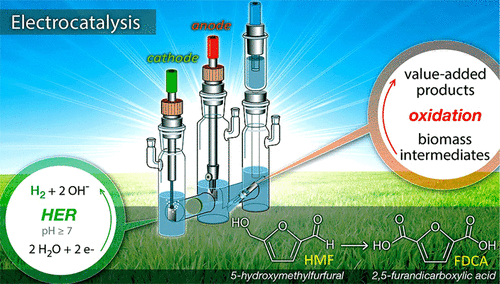当前位置:
X-MOL 学术
›
ACS Sustain. Chem. Eng.
›
论文详情
Our official English website, www.x-mol.net, welcomes your
feedback! (Note: you will need to create a separate account there.)
Nanoengineered Electrodes for Biomass-Derived 5-Hydroxymethylfurfural Electrocatalytic Oxidation to 2,5-Furandicarboxylic Acid
ACS Sustainable Chemistry & Engineering ( IF 7.1 ) Pub Date : 2021-01-19 , DOI: 10.1021/acssuschemeng.0c07480
Dimitrios A. Giannakoudakis 1, 2 , Juan Carlos Colmenares 2 , Dimitrios Tsiplakides 1 , Konstantinos S. Triantafyllidis 1, 3
ACS Sustainable Chemistry & Engineering ( IF 7.1 ) Pub Date : 2021-01-19 , DOI: 10.1021/acssuschemeng.0c07480
Dimitrios A. Giannakoudakis 1, 2 , Juan Carlos Colmenares 2 , Dimitrios Tsiplakides 1 , Konstantinos S. Triantafyllidis 1, 3
Affiliation

|
Over the last decades, there has been significant progress toward the development of advanced electrochemical processes in the fields of energy production and storage, surface modification of materials and environmental remediation. Within the context of biomass valorization and biorefineries, the electrochemical oxidation of 5-hydroxymethylfurfural (HMF), one of the top biomass-derived platform chemicals, to 2,5-furandicarboxylic acid (FDCA), a valuable monomer and building block of polyethylene furanoate (PEF), has emerged as a promising sustainable alternative to the chemo-catalytic synthesis paths. An additional asset of the electrochemical route is the simultaneous production of H2. The rational design of efficient nanocatalysts and nanoengineered anodes requiring lower oxidation potential is anticipated to lead to HMF electrocatalytic oxidation at even smaller applied voltage. Additionally, the utilization of heterogeneous photocatalysis combined with advantages offered by photoelectrodes capable to utilize directly the solar light, known as photoelectrochemical (PEC) catalysis, can limit the application of external voltage. This review covers all recent developments related to electrochemical oxidation of HMF to FDCA, with emphasis on the nanoengineered anodes and their structural, morphological and chemical features, as well as with regard to the associated reaction mechanisms. The potential of solar-driven photoelectrochemical oxidation methods and continuous flow electrochemical oxidation is also discussed.
中文翻译:

纳米工程电极,用于生物质衍生的5-羟基甲基糠醛电催化氧化为2,5-呋喃二甲酸
在过去的几十年中,在能源生产和存储,材料的表面改性和环境修复等领域,先进的电化学方法的开发取得了重大进展。在生物质增值和生物精炼厂的背景下,将最主要的生物质衍生平台化学品之一的5-羟甲基糠醛(HMF)电化学氧化成有价值的单体和呋喃聚乙烯酸酯的结构单元2,5-呋喃二甲酸(FDCA)。 (PEF)已成为化学催化合成途径的有前途的可持续替代品。电化学路线的另一项资产是同时生产H 2。预期需要较低氧化电势的有效纳米催化剂和纳米工程阳极的合理设计将导致在更小的外加电压下进行HMF电催化氧化。另外,将非均相光催化的利用与能够直接利用太阳光的光电极所提供的优点相结合,称为光电化学(PEC)催化,会限制外部电压的施加。这篇综述涵盖了与HMF电化学氧化为FDCA有关的所有最新进展,重点是纳米工程阳极及其结构,形态和化学特征,以及相关的反应机理。还讨论了太阳能驱动的光电化学氧化方法和连续流电化学氧化的潜力。
更新日期:2021-02-08
中文翻译:

纳米工程电极,用于生物质衍生的5-羟基甲基糠醛电催化氧化为2,5-呋喃二甲酸
在过去的几十年中,在能源生产和存储,材料的表面改性和环境修复等领域,先进的电化学方法的开发取得了重大进展。在生物质增值和生物精炼厂的背景下,将最主要的生物质衍生平台化学品之一的5-羟甲基糠醛(HMF)电化学氧化成有价值的单体和呋喃聚乙烯酸酯的结构单元2,5-呋喃二甲酸(FDCA)。 (PEF)已成为化学催化合成途径的有前途的可持续替代品。电化学路线的另一项资产是同时生产H 2。预期需要较低氧化电势的有效纳米催化剂和纳米工程阳极的合理设计将导致在更小的外加电压下进行HMF电催化氧化。另外,将非均相光催化的利用与能够直接利用太阳光的光电极所提供的优点相结合,称为光电化学(PEC)催化,会限制外部电压的施加。这篇综述涵盖了与HMF电化学氧化为FDCA有关的所有最新进展,重点是纳米工程阳极及其结构,形态和化学特征,以及相关的反应机理。还讨论了太阳能驱动的光电化学氧化方法和连续流电化学氧化的潜力。































 京公网安备 11010802027423号
京公网安备 11010802027423号